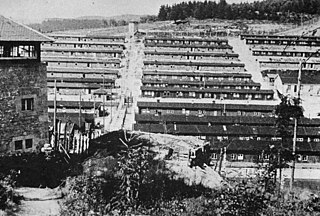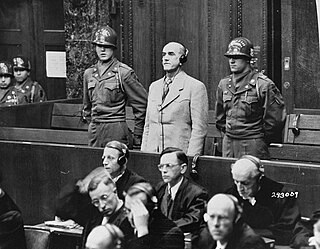Holding company for SS industries
In July 1940, Oswald Pohl (acting on the advice of Walter Salpeter [ de ] and Hans Hohberg [ de ]) set up DWB as a holding company for the majority of SS-owned enterprises in order to offset the profits of other SS companies with the losses of German Earth and Stone Works's unsuccessful brickworks at Oranienburg I (Sachsenhausen concentration camp), reducing the taxes due.
DWB was a holding company for more than 25 SS industries. Oswald Pohl, the head of the SS Main Economic and Administrative Office (known by its German initials as WVHA) was also the chief officer of DWB. Georg Lörner, another high WVHA official, was another incorporator. [3] Through stock ownership DWB controlled a wide variety of enterprises, such as stone quarries, brick manufacturing plants, cement mills, pharmaceutical factories, real estate, housing, building materials, book printing and binding, porcelain and ceramics, mineral water and fruit juices, furniture, foodstuffs, and textiles and leather. [4] Some of these businesses and properties had previously been seized or otherwise expropriated from their rightful owners.
The following companies were part of the holding (sorted in groups): [5]
Group Construction materials, Ceramics und Porzellan
Group Food and Beverages
Group Paper, Printing and Publishing
- Papierfabrik Neudeck AG
- SS-Druckschriftenversand GmbH
- Forschungsanstalt für das Deutsche Buchwesen GmbH
- Lumbeck-Gesellschaft für das deutsche Buchwesen mbH
- SS-Vordruck-Verlag GmbH
- Völkischer Kunstverlag GmbH
- Großdeutscher Bilderdienst GmbH
- Friedrich Franz Bauer GmbH
- Deutsche Briefkasten-Reklame GmbH
- Nordland-Verlag
Group Settlement and Infrastructure
- Gesellschaft für technisch-wirtschaftliche Entwicklung mbH (Getewent)
- Siedler Wirtschaftsgemeinschaft Zamosc GmbH
- Allod Eigenheim- und Kleinsiedlungs GmbH
- Erste Gemeinnützige Baugesellschaft für Kleinwohnungen GmbH
- Haus- und Grundbesitz GmbH
- Gemeinnützige Wohnungs- und Heimstättengesellschaft mbH
Group Textil and Glas
Group Furniture and Interior
- Deutsches Sperrholz- und Fournierwerk GmbH
- Verkaufsstelle Berliner Möbelwerkstätten eGmbH
- Deutsche Ausrüstungswerke GmbH (DAW)
- Deutsche Meisterwerkstätten GmbH [6]
- Deutsche Heimgestaltung GmbH
- Deutsche Edelmöbel GmbH
Groupe other Enterprises

Flossenbürg was a Nazi concentration camp built in May 1938 by the SS Main Economic and Administrative Office. Unlike other concentration camps, it was located in a remote area, in the Fichtel Mountains of Bavaria, adjacent to the town of Flossenbürg and near the German border with Czechoslovakia. The camp's initial purpose was to exploit the forced labor of prisoners for the production of granite for Nazi architecture. In 1943, the bulk of prisoners switched to producing Messerschmitt Bf 109 fighter planes and other armaments for Germany's war effort. Although originally intended for "criminal" and "asocial" prisoners, after Germany's invasion of the Soviet Union, the camp's numbers swelled with political prisoners from outside Germany. It also developed an extensive subcamp system that eventually outgrew the main camp.

Oswald Ludwig Pohl was a German SS functionary during the Nazi era. As the head of the SS Main Economic and Administrative Office and the head administrator of the Nazi concentration camps, he was a key figure in the Final Solution, the genocide of the European Jews. After the war, Pohl went into hiding; he was apprehended in 1946. Pohl stood trial in 1947, was convicted of crimes against humanity, and sentenced to death. After repeatedly appealing his case, he was executed by hanging in 1951.

Allgemeine Elektricitäts-Gesellschaft AG was a German producer of electrical equipment. It was established in 1883 by Emil Rathenau as the Deutsche Edison-Gesellschaft für angewandte Elektricität in Berlin.

German Earth and Stone Works was an SS-owned company created to procure and manufacture building materials for state construction projects in Nazi Germany. DEST was a subsidiary company of Amtsgruppe W of SS Main Economic and Administrative Office (WVHA). Both Amt. W and the WVHA were headed by Waffen-SS generals Oswald Pohl and Georg Lörner.

The Pohl trial against the Nazi German administration of the "Final Solution" was the fourth of the thirteen trials for war crimes that the United States authorities held in their occupation zone in Germany in Nuremberg after the end of World War II. The thirteen trials were all held before U.S. military courts, not before the International Military Tribunal, although both courts presided in the same rooms at the Palace of Justice. They are known collectively as the "Subsequent Nuremberg Trials" or more formally, as the "Trials of War Criminals before the Nuremberg Military Tribunals" (NMT).

Deutsche Waffen- und Munitionsfabriken Aktiengesellschaft, known as DWM, was an arms company in Imperial Germany created in 1896 when Ludwig Loewe & Company united its weapons and ammunition production facilities within one company. In 1896 Loewe founded Deutsche Waffen- und Munitionsfabriken with a munitions plant in Karlsruhe (Baden), formerly Deutsche Metallpatronenfabrik Lorenz, and the weapons plant in Berlin. Shares that Loewe had in other gun- and ammunition plants were transferred to DWM. This included Waffenfabrik Mauser, Fabrique Nationale d'Armes de Guerre (FN) in Belgium and Waffen- und Munitionsfabrik A.G. in Budapest. The DWM was orchestrated by Isidor Loewe (1848–1910), as his brother Ludwig had died in 1886. Karl Maybach was employed by the Loewe company in 1901.
Ludwig Loewe was a German merchant, manufacturer, philanthropist and a member of the Reichstag. Loewe's companies became involved in the production of armaments, employing famous designers and creating notable guns.

The SS Main Economic and Administrative Office was a Nazi organization responsible for managing the finances, supply systems and business projects of the Allgemeine-SS. It also ran the concentration camps and was instrumental in the implementation of the Final Solution through such subsidiary offices as the Concentration Camps Inspectorate and SS camp guards.

The August Frank memorandum of 26 September 1942 was a directive from SS Lieutenant General August Frank of the SS concentration camp administration department (SS-WVHA). The memorandum provides a measure of the detailed planning that Frank and other Nazis put into the carrying out of the Holocaust. It includes instructions as to the disposition of postage stamp collections and underwear of the murdered Jews. It is clear that the Nazis were intent in removing everything of value from their victims.

August Franz Frank was a German SS functionary in the SS Main Economic and Administrative Office, generally known by its German initials WVHA. The WVHA was, among other things, responsible for the administration of the Nazi concentration camps. After the war, the higher WVHA officials, including Frank, were tried and convicted of crimes against humanity.

Georg Nikolaus Lörner was a German SS functionary during the Nazi era. He served as Deputy Chief under Oswald Pohl, of the SS Main Economic and Administrative Office. Lörner was in charge of maintaining the clothing supplies for concentration camps.

The Deutsche Gesellschaft für Schädlingsbekämpfung mbH, oft shortened to Degesch, was a German chemical corporation which manufactured pesticides. Degesch held the patent on the infamous pesticide Zyklon, a variant of which was used to execute people in the gas chambers of German extermination camps during the Holocaust. Through the firms Tesch & Stabenow GmbH (Testa) and Heerdt-Linger (Heli), Degesch sold the poisonous gas Zyklon B to the German Army and the Schutzstaffel (SS).
Anton Loibl GmbH was a company owned by the SS which was a funding source for the Ahnenerbe research branch and the Lebensborn eugenics programme. It was created to market a bicycle reflector invented by Anton Loibl, a chauffeur for Hitler. It employed slave labour.

Ostindustrie GmbH was one of many industrial projects set up by the Nazi German Schutzstaffel (SS) using Jewish and Polish forced labor during World War II. Founded in March 1943 in German-occupied Poland, Osti operated confiscated Jewish and Polish prewar industrial enterprises, including foundries, textile plants, quarries and glassworks. Osti was headed by SS-Obersturmführer Max Horn, who was subordinated directly to Obergruppenführer Oswald Pohl of the SS Main Economic and Administrative Office. At its height, some 16,000 Jews and 1,000 Poles worked for the company, interned in a network of labor and concentration camps in the Lublin District of the semi-colonial General Government territory.
German Equipment Works was a Nazi German defense contractor with headquarters in Berlin during World War II, owned and operated by the Schutzstaffel (SS). It consisted of a network of requisitioned factories and camp workshops across German-occupied Europe exploiting the prisoner slave labour from Nazi concentration camps and the Jewish ghettos in German-occupied Poland. DAW outfitted the German military with boots, uniforms and materials on the eastern front at a windfall profit, and provided wood and metal supplies, as well as reconstruction work on railway lines and freight trains.

Granitwerke Mauthausen was one of the names used by the DEST company for its branch based in Sankt Georgen an der Gusen and which exploited the slave manpower confined in certain subcamps of the Mauthausen-Gusen concentration camp system: Gusen I, Gusen II, Gusen III, and Mauthausen.

Többens and Schultz was a Nazi German textile manufacturing conglomerate making German uniforms, socks and garments in the Warsaw Ghetto and elsewhere, during the occupation of Poland in World War II. It was owned and operated by two major war profiteers: Fritz Emil Schultz from Danzig, and a convicted war criminal, Walter C. Többens.

DMT-Gesellschaft für Lehre und Bildung mbH (DMT-LB), based in Bochum, is a collective association of the German coal mining industry and acts as the funding organisation of Deutsches Bergbau-Museum Bochum and Technische Hochschule Georg Agricola. It was established as the Westfälische Berggewerkschaftskasse (WBK) in 1864 and merged with the Steinkohlen-Bergbau-Verein (Stbv) and Bergbau Forschung GmbH under the auspices of DeutscheMontanTechnologie e.V. (DMT) in 1990.

Forced labor was an important and ubiquitous aspect of the Nazi concentration camps which operated in Nazi Germany and German-occupied Europe between 1933 and 1945. It was the harshest and most inhumane part of a larger system of forced labor in Nazi Germany.

















